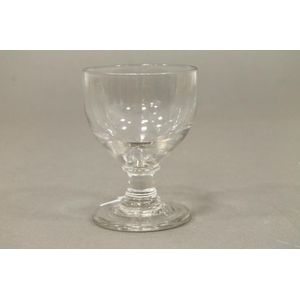Large Jacobite Goblet with Engraved Rose and Stem
You must be a subscriber, and be logged in to view price and dealer details.
Subscribe Now to view actual auction price for this item
When you subscribe, you have the option of setting the currency in which to display prices to $Au, $US, $NZ or Stg.
- Knop (glass) - In Georgian glassware, the knop is a bulbous protrusion, usually midway up the stem of the glass. It may be included singly or in groups, and may be hollow or solid. There are many styles of knop including basal, baluster, bell, acorn, cone, flattened, melon and mushroom.
- Jacobite - Wine glasses engraved with mottos and symbols of the Jacobites, who were supporters of Prince Charles Edward Stuart's claim to the English throne.
They were passed around amongst the members of secret groups devoted to the restoration of a Catholic monarch in Scotland and England under the House of Stuart.
The last Jacobite Rebellion ended with Charles Edward Stuart?s defeat at the Battle of Culloden in 1746. His image features on some of the Jacobite glassware.
Genuine examples of Jacobite glassware are dated between 1746 and 1788 but many later copies and forgeries are in circulation.
In November 2012 a Jacobite "Amen" glass, the rarest group of Jacobite glasses sold for £43,000 at auction in Shropshire, England. - Knop - In Georgian glassware, the knop is a bulbous protrusion, usually midway up the stem of the glass. It may be included singly or in groups, and may be hollow or solid. There are many styles of knop including basal, baluster, bell, acorn, cone, flattened, melon and mushroom.
- Bowl - With drinking glasses, the bowl is the hollow section of the glass that holds the liquid. Many glasses were mounted on a stem joined to a foot, others were cylindrical, of tumbler shape. The size and shape of the bowl was determined by the type of liquids they were meant to hold. Shapes used included bell shaped, conical (funnel), bucket shaped, trumpet, cup, ogee, funnel, cylindrical and rounded.
- Folded Foot - A drinking glass with a rounded edge to the foot, where the foot is effectively double-layered by turning it, usually under but sometimes over and then flattened , against the disk of the foot, to provide extra stability and reduce the risk of chipping or breakage.
The technique originated in Venice during the Renaissance and was adopted by English glassmakers who continued to fold the feet of drinking glasses and bowls until c1750. - Engraved Glass - The method of decorating glass by marking the surface with a sharp intrument such as a diamond, metal needle or rotating cutting wheel. As pressure is applied to the surface, best results for engraving are achieved if the glass is of sufficient thickness. In the 19th century etching was used to decorate some table glassware that was too fine to take an engraving tool.
- Circa - A Latin term meaning 'about', often used in the antique trade to give an approximate date for the piece, usually considered to be five years on either side of the circa year. Thus, circa 1900 means the piece was made about 1900, probably between 1895 and 1905. The expression is sometimes abbreviated to c.1900.
- Stem - In drinking glasses the stem is that section of the glass that joins the bowl to the foot. In mass produced glasses is usually solid and of cylindrical shape, but in antique drinking glasses it may be long and short and in various styles or with decoration, such as air twist, baluster, collared, faceted, hollow, knopped, teardrop, twisted or incised.
This item has been included into following indexes:
Visually similar items

A fine Newcastle wine glass, circa 1750 the pointed round funnel bowl with solid base, Dutch engraved with the motto ' Vaincre ou Mourir ', (Conquer or Perish) and depicting fighting cocks, supported on a cushioned annular shoulder knop above a teared drop

A fine Newcastle goblet, circa 1740 the round solid based funnel bowl Dutch engraved with Het Aanstande Huwelyr and depicting naval motifs, supported on a stem with shoulder annular and cushioned beaded central baluster terminating in a plain foot, 18 cm h

An early Victorian rummer glass with bucket bowl and plain stem with circular foot. Height 14.3 cm

A Georgian blown glass cup bowl rummer collard stem and circular foot. Pontil mark. Height 12.6 cm
